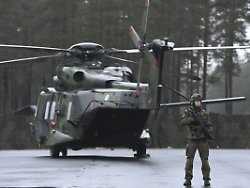Only on one leg soon?
Finland’s balancing act between Russia and NATO
05/08/2022, 10:50 a.m
In Europe, only the Ukraine has a longer border with Russia: The much smaller Finland therefore had to learn to come to terms with its oversized neighbor. However, the long and comparatively stable arrangement with Russia is now beginning to falter.
If your own home borders on a powerful neighbor over a whopping 1340 kilometers, then you are reluctant to forfeit it. This awareness has always shaped Finland’s relationship with Russia and ultimately prevented the Nordic country from becoming a member of NATO. Then Russia attacked Ukraine, sparking a rapid shift in opinion among Finns – and suddenly the EU’s northernmost country is on the verge of applying for NATO membership. Because if an overpowering neighbor suddenly becomes an acute danger, then you have to act.
The Finns know this from their own history: they fought the Russians twice in the past century, first in the Winter War of 1939, then again alongside Nazi Germany. With an extraordinary balancing act, the country still managed to get on well with both Russia and the West in the post-war period. A Finnish NATO application, which could possibly come in a few days, would now significantly shift this East-West balance. The changeable Finnish-Russian history is thus facing a new, conflict-ridden chapter.
“It’s a complicated story,” says Henrik Meinander about Finnish-Russian relations. The historian from the University of Helsinki has recorded the history of his country with all its turning points in a book. In it he describes, among other things, how Finland was able to avoid “Sovietization” after the Second World War and how Stalin worked to ensure that the country did not fall into the orbit of the West and NATO.
“Mutilated and Wounded, but Independent”
Finland has long been part of the Kingdom of Sweden. This kingdom was attacked by Russia in 1808, after which the Finns fell under the rule of the Russian Empire for more than 100 years. For the Russians, this was important because of the proximity of the southern Finnish border to their metropolis, St. Petersburg. As a Russian grand duchy, however, Finland managed to remain largely autonomous: Swedish laws, the constitution and Western religion continued to apply, but the Russians made Helsinki the Finnish capital instead of Turku as before.
In the course of the October Revolution in 1917, Finland declared itself independent. However, Finnish-Russian relations remained complicated. After a fake Finnish provocation at the border town of Mainila, Russia carried out its last military attack on Finland in 1939, but was surprised by how vehemently the Finns put up a fight in the Winter War.
In the Continuation War, the country entered into an ambivalent brotherhood in arms with Nazi Germany, but then concluded a peace treaty with Moscow, in the course of which it had to cede territories. The Finnish civilian population undoubtedly suffered from the war, but it got off lightly compared to many other countries, writes Meinander. “Finland was maimed and wounded but remained independent.”
The end of the “Finlandization” of Finland?
The post-war period in Finland was characterized above all by the development of a welfare state and a new Ostpolitik. A friendship agreement was concluded with the Soviet Union in 1948, which obliged Finland to support its large neighbor in the event of a German attack. At the same time, the Finns established growing trade relations with the West. They thus diligently fine-tuned their profile as a neutral state.
This policy was shaped in particular by long-serving President Urho Kekkonen. He stood for continuity and predictability in relation to the Soviet Union. He believed that the better relations with the Soviets, the greater the chances of developing Western relations. Kekkonen liked to call this balancing act between East and West “the Finnish paradox” – critics, on the other hand, spoke disparagingly of a “Finlandization”.
Even if Finland remained militarily non-aligned, it later oriented itself further and further towards the West: Germany’s reunification was a good reason to terminate the friendship agreement with the Soviet Union. In 1995 Finland was finally admitted to the EU, which connected the country much more strongly with Western and Central Europe. The Nordic country, like neighboring Sweden, has been a close NATO partner for a long time – but has not yet been an official member.
“Putin practically decided for Finland to join NATO himself”
Finland’s history with Russia has many layers, Meinander sums up. The relationship with the big neighbor to the east was characterized more by pragmatism than fear, with one goal always being central: “The entire Finnish identity is built on the idea that we want to prevent Finland from becoming part of Russia. It’s crucial that we don’t want to become Russian.”
According to historian Kimmo Rentola, the once good relationship between Russia and Finland has slowly deteriorated under Kremlin chief Vladimir Putin. He is one of the leading experts on Finnish-Russian relations and reckons that Finland’s entry into NATO would certainly create tension, but would ultimately be a consequence of Putin’s own actions.
“In fact, Putin practically decided himself that Finland would join NATO,” says Rentola. Before the Russian invasion of Ukraine, a majority of Finns had never spoken out in favor of NATO membership. “February 24th changed that completely.” The paradox is that Putin really wanted to prevent countries like Finland and Sweden from doing just one thing: joining NATO.
